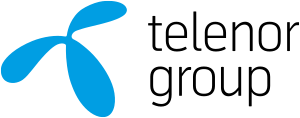Telenor facts for kids
 |
|
| State-owned Allmennaksjeselskap | |
| Traded as | OSE: TEL |
| Industry | Telecommunications |
| Founded | 1855 |
| Headquarters | Fornebu, Norway |
|
Key people
|
Sigve Brekke (President and CEO), Gunn Wærsted (Chair of the Board) |
| Products | Fixed line and mobile telephony, internet, digital television, IT services, IPTV |
| Revenue | |
|
Operating income
|
|
| Total assets | |
| Total equity | |
| Owner | Government of Norway (54%) Free float (46%) |
|
Number of employees
|
20,044 (end 2019) |
Telenor ASA is a large company from Norway. It is mostly owned by the Norwegian government. Telenor is a multinational company that provides telecommunications services. This means they offer things like mobile phones, internet, and TV.
Telenor's main office is in Fornebu, near Oslo. It is one of the biggest mobile phone companies in the world. Telenor works in many countries, especially in Scandinavia (like Norway, Sweden, Denmark) and Asia. They also offer broadband internet and TV services in four Nordic countries. Telenor is also exploring new technologies like Machine-to-Machine (M2M) communication.
Telenor is listed on the Oslo Stock Exchange. In 2015, it was the third largest company listed there.
Contents
How Telenor Began
Telenor started a long time ago, in 1855. Back then, it was called Telegrafverket. It was a government-run company that provided telegraph services. A telegraph sends messages over long distances using electric signals.
The First Telegraph Lines
The idea for a telegraph system in Norway started in 1848. By 1852, the Norwegian Parliament decided to build a country-wide telegraph system. Telegrafverket began by connecting Christiania (which is now Oslo) to Sweden. They also connected Christiania to Drammen.
By 1857, the telegraph reached Bergen on the west coast. By 1871, it reached Kirkenes in the far north. Telegraph cables were also laid to Denmark in 1867 and to Great Britain in 1869. The telegraph was very important for ships and businesses. It helped them communicate quickly and improve their logistics.
The Start of Telephone Services
The first telephone service in Norway began in 1878. It connected Arendal and Tvedestrand. The first international phone call from Christiania to Stockholm happened in 1893.
The telephone system became automatic starting in 1920. This process was finished in 1985. In 1946, the first Telex service was offered. In 1976, satellite phone connections were set up for Norwegian ships and oil platforms in the North Sea. This was the beginning of Inmarsat Satellite Communication. It also led to the telephone network becoming digital between 1980 and 1985.
Mobile Phones and New Technologies
Televerket (the company's name changed in 1969) launched its first manual mobile phone system in 1966. This was replaced by the automatic NMT system in 1981. An improved version, NMT-900, came in 1986. Norway was the first country to have an automatic mobile phone system.
The digital GSM system started in 1993. The third generation of mobile technology (3G) with the UMTS system began in 2004. The Opera web browser was created in 1994 by people working at Telenor. Opera Software was then started in 1995. Telenor and Huawei have even tested 5G technology, reaching very fast speeds in a lab.
Becoming a Public Company and Going Global
In 1969, the company changed its name to Televerket. In 1994, it became a public company called Norwegian Telecom. The rules for telecom companies in Norway became more open between 1994 and 1998.
An attempt to combine Telenor with the Swedish company Telia failed in 1999. Both companies were still owned by their governments at that time. On December 4, 2000, Telenor became partly private. Its shares were listed on the Oslo Stock Exchange and NASDAQ. This helped the company get new money. The Government of Norway still owned most of the company (77.7%). By 2014, the Norwegian government owned about 54% of Telenor.
In the late 1990s, Telenor started mobile operations in other countries. These included Russia (1994), Bangladesh, Greece, Ireland, Germany, and Austria (1997). They also expanded to Ukraine (1998), Malaysia (1999), Denmark and Thailand (2000), Hungary (2002), Montenegro (2004), Pakistan (2004), Slovakia, Czech Republic, and Serbia (2006), and Myanmar (2014). Some operations in Greece, Ireland, and Germany were sold in 1999-2000. The money from these sales was used to invest in new markets. In 2005, Telenor bought Vodafone Sweden and changed its name to Telenor in 2006.
Grameenphone was Telenor's first project in Asia. It is now the largest mobile operator in Bangladesh. Telenor owns 55.8% of Grameenphone. Its success led Telenor to focus more on Asia. They successfully entered Malaysia, Thailand, Pakistan, and Myanmar. Telenor also tried to enter India, but left that market in 2017.
In 2018, Telenor sold its businesses in Southeast Europe. This included operations in Bulgaria, Hungary, Montenegro, and Serbia. They sold them to the PPF Group for 2.8 billion euros. This was done to focus more on Asia and the Nordic market.
In 2019, Telenor bought DNA, a big mobile operator in Finland. In 2021, Telenor and Axiata agreed to combine their companies Celcom and Digi in Malaysia. This merger was planned to create a stronger telecom company. Also in 2021, Telenor and Charoen Pokphand Group agreed to explore combining their telecom companies in Thailand, True Corporation and Total Access Communication (DTAC).
What Telenor Does Now
Telenor offers many telecommunication services in the Nordic Countries. These include mobile and fixed phone services, internet access, and cable TV. Telenor is still the biggest telecom company in Norway.
The company is also a major player in the Scandinavian Broadband and TV market. They have many customers and wide coverage. Their TV distribution is called Allente. Telenor is also important in Asia, with operations in five different countries there.
At the end of 2021, Telenor had control of mobile operations in Norway, Denmark, Finland, Sweden, Thailand, Malaysia, Bangladesh, Myanmar, and Pakistan. The Myanmar operation was sold in 2021 and the sale was completed in March 2022.
| Country | Operator | Native name | Ownership stake | 2019 revenue (million NOK) |
|---|---|---|---|---|
| Telenor Norway | Telenor | 100% | 28 658 | |
| Telenor Denmark | Telenor | 100% | 4 871 | |
| DNA | DNA | 100% | 3 433 | |
| Telenor Sverige | Telenor | 100% | 12 857 | |
| Grameenphone | গ্রামীণফোন | 55.8% | 14 980 | |
| DiGi | digi | 49% | 13 572 | |
| Telenor Pakistan | ٹیلی نار | 100% | 6 033 | |
| dtac | ดีแทค | 42.61% | 22 994 |
Telenor Maritime Radio manages the system for radio communication at sea in Norway. They have five coast radio stations with staff. Their main job is to listen to radio traffic from ships and help vessels in trouble.
Research and Development
Telenor Research is the company's research department. They study things like markets, technology, data, new ideas, and how organizations work. Telenor Research gives advice and recommendations to the Telenor Group and its different business units. Their goal is to create value for Telenor through their research.
Machine-to-Machine (M2M) Technology
Telenor started looking into M2M technology in 2000. M2M means devices talking to each other without human help. For example, a smart meter sending electricity readings automatically. Telenor has created two companies for this: Telenor Connexion and Telenor Objects. This effort has given them a large share of the M2M market in Europe. For example, Nissan uses Telenor's M2M technology to connect its electric cars in Europe.
Broadcast Services
Canal Digital was a company fully owned by Telenor. It was a major TV content provider in the Nordic region. In 2021, Canal Digital merged with Viasat to form Allente.
Telenor also runs the national TV broadcast network in Norway through its company Norkring.
Thor is a group of satellites owned by Telenor. On February 11, 2008, the THOR 5 satellite was launched into space. Telenor controls three satellites (THOR5, THOR6, and THOR7) from its control center in Fornebu.
Past Operations
After Telenor became partly private, it sold off several parts of its business. These included Bravida, which was its installation division, and Findexa, which made telephone directories. The web browser company Opera Software actually started in Telenor's research department. Telenor also used to provide satellite communication services, but this division was sold in 2007.
Telenor has also operated mobile phone networks in many international markets in the past, but later sold them:
| Country | Year of entry | Year of exit |
|---|---|---|
| 1997 | 1999 | |
| 1997 | 1999 | |
| 1997 | 2000 | |
| 1998 | 2005 | |
| 1998 | 2005 | |
| 1997 | 2007 | |
| 2009 | 2017 | |
| 2006 | 2018 | |
| 2004 | 2018 | |
| 2013 | 2018 | |
| 2002 | 2018 | |
| 1994 | 2019 | |
| 1998 | 2019 | |
| 2014 | 2021 |
Images for kids
-
Old style Telenor Mobile SIM, with the former company logo.
See also
 In Spanish: Telenor para niños
In Spanish: Telenor para niños







